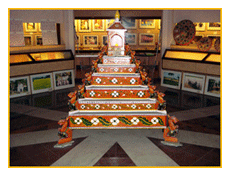
Assamese literature came into prominence with the rise of the neo-Vaisnavite movement in Northern India in the 14th C. Sankaradeva (1449-1469) changed the faith of the province and turned the minds of the people from the priest-ridden ceremonies; he propounded through the people’s language the cult of Bhakti, ‘the worship of a personal deity, Visnu or Krishna, in a spirit of love and adoration.’ The Vaisnavism he preached is known as Ekasarana dharma, the religion of supreme surrender to One, and that One is Visnu. The favourite incarnation in which Visnu is to be worshipped is that of Vasudeva Devakiputra.
The religious activities of Sankaradeva and his followers did not end in teaching, preaching and winning converts. They made a sincere and systematic attempt to bring the unlettered people into contact with the Puranic learning. Sankaradeva himself composed a large number of books, consisting of translations, commentaries, and original works in exposition of his creed. He rendered into verse the last canto of the Ramayana, and certain cantos of the Bhagavata Purana. The translator every-where makes an attempt to elaborate and simplify the difficult ideas and expressions of the texts into simple Assamese.
Sankaradeva’s other important verse compositions are Nibinava Siddha, Kirtan Ghosa, Bhakti Pradip and Rukmini Haran Kavya. Among all his compositions Kirtan Ghosa is the most important; it has exercised a unique influence upon the mind and thought of the Assamese people. It is a collection of about thirty poems comprising about 2,398 verses in diverse metres. Each poem depicts an episode (akhyana) glorifying the deeds of Vishnu or Krishna: Sishulila (early life of Krishna), Ajamil Upakhyana (episode about Ajamil), Bali Chalan (deception of Bali), Kamsa Vadha (killing of Kamsa) etc. For its superb beauty of musical language, its entertaining and wonderful way of story-telling, its presentation of the didactive and worldly maxims through parables and akhyanas, Kirtan Ghosa has a unique importance in our literature.
Rukmini Haran is a charming kavya, modelled after Sanskrit epics. It is a love romance of Rukmini and Krishna. Snakaradeva made the theme admirably popular and transformed commonplace ideas into neat and witty maxims, which even today are quoted as proverbial expressions.
In two other branches of Assamese literature Sankaradeva was a pioneer: Ankiya Nat (one-act play); and Bargit (devotional song). No other vernacular literature of India of the period seems to possess much dramatic compositions. Of his many dramas, Ramavijaya, Kaliya-damana, Parijataharana, Rukminiharana, Patniprasad are the best known; they are performed even today in the village Namaghars. The Ankiya Nats are of the nature of the early church dramas, mysteries and miracles, of England. Their subject is short and simple and represents some episode from the life of Krishna or Rama. The lyrical element preponderates; and songs set to different tunes are interspersed; in fact, most of the incidents of the play, instead of being represented on the stage, are reported through songs. The dialogue is meagre, and the prose is rhythmic in structure. All these elements combine to invest an Ankiya Nat with a hymnic solemnity.
Bargits, great songs or ‘noble numbers’ as opposed to secular songs, are usually of four to sixteen lines bearing a refrain and a notation. The refrain is either an invocation or an exhortation. Some of the Bargits are contemplative and reflective upon the nature of God, his relation with the world. His compassion, the innate sufferings of human existence, the path of liberation. Others are exhortatory, urging men ‘to chant the name of Hari,’ ‘to think of Govinda,’ ‘to rest on the feet of Rama,’ ‘to leave the transitory pleasures of the world.’ Each Bargit invariably concludes with a passionate prayer for refuge at the feet of Hari and deliverance from this world of illusion. Some of these spiritual songs are allegorical in import:
This world is a dense forest,
Full of the fetters of desire;
And myself, a weakling of a deer,
Wander here alone.
Take, like a hunter
Charges me fast.
I am entrapped by the fetters of Maya.
O Hari, I have lost my heart,
And know not the way to liberation.
Even to think of my lot,
I burn within.
Avarice and illusion, the two tigers,
Are following me.
Save me, O Infinite Good one!
There is another class of popular allegorical songs known as Deh Bicharar Git (psychophysiological songs depicting the body as a microcosm). With homely images the Deh Bicharar Git describes the transitoriness and worthlessness of the human body. The songs are beautiful, but lack the tenderness of sentiment and loftiness of thought of the songs of the Vaisnavite poets. Their appeal lies mainly to the common people. Their origin may be ascribed to the latter day Buddhistic literature of the Tantras.
The next outstanding figure in the Assamese Vaisnavite movement was Madhavadeva, the disciple of Sankaradeva. At the direction of his Guru, Madhavadeva rendered Vishnupuri’s Sanskrit Bhakti Ratnavali, an anthology of nine-fold forms of Bhakti, into Assamese verse. But the poem by which Madhavadeva is best known, and which is the highest achievement of Assamese Vaisnavite hymnic composition is the Nama Ghosa, also known as Hazari Ghosa (the book of a thousand stanzas). It contains a large number of hymns on repentance and entreaty, self-instruction, and self-reproach. In each of them the lyric cry is predominant and passionate. The last few sections of the book serve as a litany, consisting of an enumeration of names, praises, and laudatory epithets of Krishna. Profundity of thought, unity of outlook, and music of expression mark the Nama Ghosa as a foremost work of art.
But what made Madhavadeva a popular figure in the Vaisnavite movement were his Bargits. His devout nature found expression in the devotional songs, full of passionate emotions. The three topics that form the main theme of some of Madhavadeva’s Bargits are this enviable human life as affording fullest scope for spiritual realisation, its uncertain nature, and fitful progress through this illusive world, where Hari-bhakti alone is the guiding star. Most of his other Bargits, however, depict the disportive childhood of Krishna, the cowherd. The conception of Krishna as a distinctive feature of Assam Vaisnavism and it has been very poetically depicted in the devotional songs and plays of Madhavadeva. In this respect, Madhavadeva’s Bargits compare very favourable with the songs of Surdas and Bhajans of Meera.
The most versatile and copious writer of the movement was Rama Saraswati. King Naranarayan of Koch Bihar directed him to make a translation of the Sanskrit Mahabharata. The king himself supplied him with the original texts, which are reported to be more than one cart-load. Many of the contemporary saint-poets offered him services and the entire work was divided among several authors. Rama Saraswati completed the translations of the Adi, Vana, Bhisma, and Birat Parvas. Besides lengthy elaborations of the original episodes and descriptions, he freely added incidents and stories from the different Puranas.
The vernacular version of the great epic gave a tremendous impetus to the growth and popularity of Assamese literature. It opened wide the doors of the vast treasure house of tales, romances, and mythical stories. It became a perennial fountain on which many of the Vaisnavite poets were nourished during the succeeding centuries.
The outstanding contribution of Rama Saraswati was his Vadha Kavyas (heroic poems). He widened the scope of Vaisnative literature by reproducing in beautiful verse a large number of heroic sagas from epics and Puranas. His Khatasur Vadha, Kulachal Vadha, Baghasur Vadha, Aswakarna Vadha are all romances of chivalry and heroic deeds. They are of stupendous length, and describe superhuman exploits and marvelous deeds of gods and mortals, often with bloody battle-scenes, interrupted by charming love episodes.
The story of Aswakarna Vadha compares very well with that of the lovely Una of Spenser’s Faerie Queene. Writing as he did in a style of both lucidity and grace, Rama Saraswati exercised a widespread and fascinating influence. His poems even today enjoy immense popularity among the people.
To popularize the essentials of religious love through songs and poetry, many Vaisnava saints re-fashioned the current folk literature to point a religious lesson. Thus Shridhar Kandali, a favorite disciple of Sankaradeva, turned a nursery tale Kan Khowa (Ear Eater) into a well-known religious poem of great beauty.
Next to the Bhagavata, the Purana that captured the imagination of the Vaisnavite saints was Harivamsa. Its popularity is proved by the existence of several versions, and numerous adaptations from it. Of the three sections of the Harivamsa, the Visnuparvan which gives the stories and legends of boy Krishna was in much demand. The authorship of the complete Assamese version is ascribed to Gopalchandra Dwija.
Bhattadeva translated the entire Bhagavata Purana and the Gita into Assamese prose. His style is conversational, but his diction is overloaded with Sanskritic words; his language is far less homely than that of the verse writers. The prose style that Bhattadeva introduced came to be looked upon as a kind of stately devotional dialect; even now, the religious heads of Satras (monasteries) employ this style in ceremonial and formal addresses to their disciples.
In this prose is also written the Caritputhis or the biographies of the saints. In the Caritputhis, the day-to-day experiences and incidents of the saint’s lives personally witnessed by the monk-compilers or handed down by sacred traditions have been laid down without shifting the importance from the insignificant and accepting legends and myths without any historical scrutiny. Be that as it may, these Caritputhis are the first attempt in Assamese at writing biographies. In addition, they contain pictures of contemporary Assamese religious life, record of manners and customs current at the time, and history of religious institutions.
The Vaisnavite period was an age when Sanskrit scholarship was also at its highest in Assam. Besides, compilation of a religious character, works on astrology Smriti, and mathematics were also written in Sanskrit. A few plays in Sanskrit have also been found composed during this period. The Vaisnavite movement gave all round impetus to Assamese life and literature, and learning and education.
Dr. B.K. Barua writes on Indian Review.




Leave a Reply